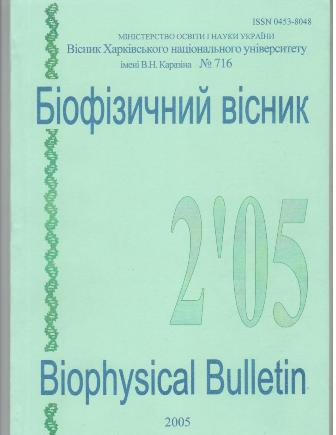Модулюючий вплив аденозинових Р1 пуринорецепторів на кальцієву сигналізацію, викликану активацією холінорецепторів в ацинарних клітинах підщелепної слинної залози
Анотація
Фізіологічна роль аденозивних рецепторів у функціонуванні ацинарних клітин слинних залоз залишається нез”ясовною. З використанням флуоресцентного Са2'-чутливого барвника фура -2/АМ проведено вимірювання концентрації іонізованого кальцію у цитоплазмі ([Са2+],) ацинарних клітин підщелепної слинної залози щурів при активації аденозинових рецепторів. Показано відсутність прямого ефекту аденозину на [Са2+] та його здатність ефективно потенціювати підвищення [Са2+] , викликане активацією холінорецепторів ацетилхоліном та карбахоліном. При цьому стимулюючий ефект аденозину на амплітуду [Са2+] , - транзиєнтів проявлявся лише при дії холіноміметиків у концентраціях нижчих за субмаксимальну. Одержані нами результати свідчать про те, що в ацинарних клітинах підщелепної слинної залози функціонують Р1 пуринорецептори, активація яких прямо не впливає на перебіг кальцієвої сигналізації, проте призводить до модуляції фосфоліпаза С - ІnsР3 сигнального шляху при активації холінорецепторів. Останнє, на нашу думку, може бути викликане фосфорилюванням ІnsР3 – рецепторів мембрани ендоплазматичного ретикулуму цАМФ - залежними протеїнкіназами.
Завантаження
Посилання
P. 4 — 25.
2. Bucheimer R.E., Linden J. Purinergic regulation of epithelial transport // J. Physiol. 2004. 555. Pt 2. P. 311 - 321.
3. Burnstock G., Knight G.E. Cellular distribution and functions of P2 receptor subtypes in different systems // Int. Rev. Cytol. 2004. 240. P. 31 - 304.
4. Cobb B.R., Ruiz P., King CM., Fortenberry J. Et al. A (2) adenosine receptors regulate CFTR through PKA and PLA (2) // Am. J. Physiol. Lung Cell Mol. Physiol. 2002. 282, № 1. P. 12- 25.
5. Evellin S., Nolte J., Tysack K. et al. Stimulation of phospholipase C-epsilon by the M3 muscarinic acetylcholine receptor-mediated by cyclic AMP and the GTPase Rap2B // J. Biol. Chem. 2002. 277, №19. P. 16805 - 168013.
6. Fedirko N., Vats Ju., Klevets M., Kruglikov I., Voitenko. N. Neuronal control of the exocytosis and calcium homeostasis //Neurophysiology. 2002. P. 144-147.
7. Feoktistov I., Biaggioni I. Adenosine A2B receptors // Pharmacol. Rev. 1997. 49, № 4. P. 381 - 402.
8. Gallacher D.V. Are there purinergic receptors on parotid acinar cells? // Nature. 1982. 296, № 5852. P. 83 - 86.
9. Grynkiewicz G., Poenie M., Tsien R.Y. A new generation of Ca2+ indicators with greatly improved fluorescence properties // J. Biol. Chem. 1985. 260, № 6. P. 3440 - 3450.
10. Linden J., Thai T., Figler H., Jin X., Robeva A.S. Characterization of human A(2B) adenosine receptors: radioligand binding, western blotting, and coupling to G(q) in human embryonic kidney 293 cells and HMC-1 mast cells // Mol. Pharmacol. 1999. 56, № 4. P. 705 - 713.
11. Ralevic V., Burnstock G. Receptors for purines and pyrimidines // Pharmacol. Rev. 1998. 50, № 3. P. 413-492.
12. Reshkin S.J., Guerra L., Bagorda A. et al. Activation of A (3) adenosine receptor induces calcium entry and chloride secretion in A (6) cells // J. Membr. Biol. 2000. 178, №2. P. 103-113.
13. Sitaraman S.V., Wang L., Wong M. et al. The adenosine 2b receptor is recruited to the plasma membrane and associates with E3KARP and Ezrin upon agonist stimulation // J. Biol. Chem. 2002. 277, №36. P. 33188 - 33195.
14. Turner J.T., Landon L.A, Gibbons S.J., Talamo B.R. Salivary gland P2 nucleotide receptors // Crit. Rev. Oral. Biol. Med. 1999. 10, № 2. P. 210-224.
15. Vats J.A, Fedirko N.V , Klevets M.Y. et al. Role of SH Groups in the Functioning of Са2+-Transporting ATPases Regulating Са2+ Homeostasis and Exocytosis //Neurophysiology. 2002. 34, №1. P. 5 - 12.
16. Zhang G. H., Martinez J.R., Effects of forskolin, dibutyryl cAMP and H89 on Ca2' mobilization in the submandibular salivary cell of newborn rats//Arch Oral. Biol. 1999. 44, № 9. P. 735 - 744.
17. Wagner L.E, Li W.H., Yule D.I. Phosphorylation of type-1 inositol 1,4,5-trisphosphate receptors by cyclic nucleotide-dependent protein kinases a mutational analysis of the functionally important sites in the S 2+ and S2- splice variants // J. Biol. Chem. 2003.278. №46. P. 45811 - 45817.
Автори, які публікуються у цьому журналі, погоджуються з наступними умовами:
- Автори залишають за собою право на авторство своєї роботи та передають журналу право першої публікації цієї роботи на умовах ліцензії Creative Commons Attribution License, котра дозволяє іншим особам вільно розповсюджувати опубліковану роботу з обов'язковим посиланням на авторів оригінальної роботи та першу публікацію роботи у цьому журналі.
- Автори мають право укладати самостійні додаткові угоди щодо неексклюзивного розповсюдження роботи у тому вигляді, в якому вона була опублікована цим журналом (наприклад, розміщувати роботу в електронному сховищі установи або публікувати у складі монографії), за умови збереження посилання на першу публікацію роботи у цьому журналі.
- Політика журналу дозволяє і заохочує розміщення авторами в мережі Інтернет (наприклад, у сховищах установ або на особистих веб-сайтах) рукопису роботи, як до подання цього рукопису до редакції, так і під час його редакційного опрацювання, оскільки це сприяє виникненню продуктивної наукової дискусії та позитивно позначається на оперативності та динаміці цитування опублікованої роботи (див. The Effect of Open Access).





